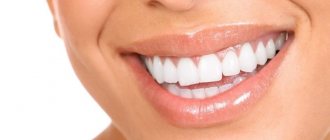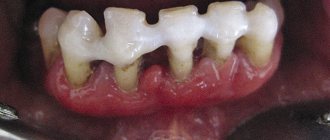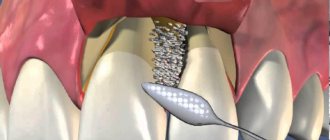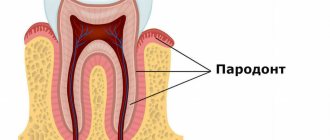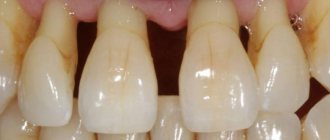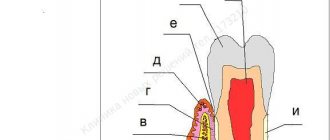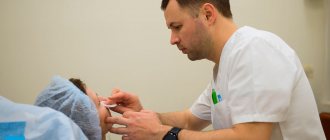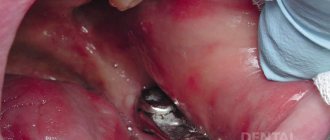Periodontal disease is...
According to the terminology of the Great Medical Encyclopedia, periodontal disease is a lesion of the periodontium of a dystrophic nature (periodontium is a complex of tissues surrounding the tooth and holding it in the alveolus, having a common origin and function).
Periodontal dystrophy is premature atrophy of the dental alveoli, characterized by progressive resorption of their bone tissue, leading to the formation of pathological periodontal pockets, suppuration from them, loosening of teeth and, often, the occurrence of alveolar abscesses. Let's bring some clarity to medical terminology. Dystrophy is the basis of the process, a violation of the complex of mechanisms (trophism) that ensure the metabolism (metabolic processes) of cells and intercellular substances and the preservation of their structure, as a result of which the function of the organ changes.
Bone resorption - in pathology - resorption of necrotic masses and reabsorption (absorption) of substances into blood or lymphatic vessels.
Alveolar abscess - formed on the alveolar process of the jaw as a result of apical purulent inflammation of the root periosteum of the tooth. The pus, which initially accumulates at the apex of the root, infects the cell and causes inflammation of the bone marrow of its walls.
Causes of periodontal disease.
The occurrence of periodontal disease is associated mainly with atrophy and sclerotic changes in the bone tissue of the jaw, which are a consequence of atherosclerotic changes in blood vessels and metabolic disorders. These may be caused by endocrine disorders, dysfunction of the gastrointestinal tract, hypovitaminosis, natural age-related changes in the body, etc. The progressive pathological process looks like this: the volume and size of the bone tissue of the alveolar processes decrease, the process of keratinization of the epithelium in the gums is disrupted, sclerotic changes appear in the periodontal vessels - they narrow (the lumen of the hollow vessel decreases). There is no inflammatory process, but visually there is exposure of the tooth necks (the presence of wedge-shaped defects), a complete absence or a small amount of dental plaque and pathological periodontal pockets. As the disease progresses, the periodontium is destroyed in its deep layers, the teeth begin to loosen, gaps appear between them, the position of the teeth changes, because of this, the chewing function is disrupted (overload when chewing). Inflammatory foci in the gum mucosa, which may appear as the disease progresses, are considered by dentists to be secondary symptoms of periodontal disease. Among the possible causes of periodontal disease are also individual characteristics of the structure of the dentition (the so-called bite) and hereditary predisposition. Individual characteristics largely determine how intensively the jaw bone tissue is reabsorbed. The risk group includes smokers, who have a much higher risk of bone atrophy.
Main symptoms of periodontal disease.
Symptoms of periodontal disease depend on how far the process of tissue atrophy has progressed. Depending on the severity of the changes, mild, moderate and severe forms are distinguished.
A mild form of periodontal disease is characterized by itching and a slight burning sensation in the gums, a decrease in the volume of gum tissue and, as a result, exposure of the roots of the teeth by a third of their length. The height of the alveolar septa decreases, the sensitivity of the necks of the teeth increases (pain when eating cold or hot food and inhaling cold air), and dental plaque appears. Against the background of various infectious (colds, for example) diseases, redness and swelling of the gums can be observed.
The symptoms of moderate and severe forms of periodontal disease manifest themselves similarly; a noticeable difference (compared to the mild form) is the more pronounced exposure of the necks of the teeth (exposing the roots of the teeth to half their length) and the gaps between the teeth. Mobility of teeth appears, which further worsens. There may be separation of pus from the gums, which looks inflamed. Or, on the contrary, neither blood nor pus is released, the color of the gums turns pale. Persistent dental deposits appear. In the future (if left untreated), the bite is completely disrupted, the teeth shift or fan out. In some teeth, the bone bed completely dissolves and the teeth fall out (without pain or blood).
Based on the clinical picture and the results of an x-ray examination (it is prescribed without fail at any stage), a diagnosis is made and treatment is prescribed. In other words, they determine the causes of periodontal disease and methods of its treatment.
Possible complications
If you ignore the symptoms of periodontal disease for too long and do not take measures to solve this problem, the disease can lead to very disastrous consequences. Pathology leads not only to aesthetic problems, but also to the complete impossibility of carrying out hygienic procedures, and nutritional problems (due to pain that occurs when mechanical action is applied to exposed roots).
An advanced form of the disease can even lead to tooth loss. Atrophic processes and destruction of the ligamentous apparatus deprive the teeth of natural support. As a result, they become very loose and fall out. To prevent such an outcome, it is important to promptly seek professional help from a specialist.
Treatment of periodontal disease.
A prerequisite for an integrated approach to the treatment of periodontal disease is the elimination of atherosclerotic changes in blood vessels. To activate blood circulation and lymph flow in the gum tissue, dentists prescribe drug therapy and massage (hardware too), hydromassage, darsonvalization, electrophoresis with vitamins. In addition, electrophoresis and physiotherapeutic procedures (galvanization and ultrasound) are used. Based on the symptoms, treatment methods (the degree of intervention in the process of preventing the development) of periodontal disease are determined. First of all, if periodontal disease is suspected, an X-ray examination is performed. If necessary, the oral cavity is sanitized: carious cavities are filled; remove teeth that cannot be treated; depulpate (remove nervous tissue, clean and fill the canal) those teeth whose bone tissue destruction has reached half the length of the tooth root. Next, dental deposits and plaque are removed either by mechanical means (teeth brushing and curettage of gum pockets), or by sandblasting, or by ultrasound. Antiseptic medications are applied to the cleaned surface of the teeth. Only after this further treatment is carried out. This may include splinting (strengthening mobile teeth) and surgical treatment. Teeth are splinted in three ways. Using fiberglass, using metal-ceramic or all-ceramic crowns welded together, or using a clasp prosthesis. The purpose of splinting is to stabilize mobile teeth. Next is a surgical intervention, the result of which is the elimination of periodontal pockets, the removal of all deposits that have appeared in them and the connective tissue that has formed in place of the destroyed bone.
Material and methods
The assessment of the provision of physiotherapeutic care in the Urals was carried out using special questionnaires that were sent to dental institutions of the republic through the organizational and methodological department of the BUZ UR RSP of the Ministry of Health of Russia (chief doctor A.M. Bogdanov). The object of the study was healthcare institutions of various forms of ownership in Izhevsk and the Urals, accepting dental patients and giving them the opportunity to receive physiotherapeutic procedures. Monitoring of 46 institutions was carried out: 16 budgetary multidisciplinary hospitals in Izhevsk with departments and dental offices, 4 state dental clinics in Izhevsk, 16 regional healthcare institutions of the Ural Republic, where the hospitals included dentists, as well as 10 privately owned dental organizations. The study included budgetary healthcare institutions with and without a physiotherapy service (department or office). In the process of studying the physiotherapeutic service, data was recorded on physiotherapeutic equipment and types of physiotherapeutic procedures that were performed on patients for various dental diseases.
To assess the adherence of dentists to physiotherapeutic treatment and patients with chronic generalized periodontitis, special questionnaires have been developed, including basic and additional questions. Based on the answers to the first 4 main questions in the questionnaires for both doctors and patients, the level or degree of compliance with physical treatment was assessed in points in accordance with the Morisky-Green method [5-7]. Moreover, with an affirmative answer to the first, second and fourth questions and a negative answer to the third question, the respondent received a maximum score of 4, and his degree of compliance was assessed as high; when receiving 3 points, adherence (compliance) was defined as insufficient, i.e., its average level, and when receiving 2 or less points, the patient was considered non-adherent, i.e., with a low level of compliance. In addition, the degree of compliance between doctors and patients was determined using the N. Insull method.
The main questions in the questionnaire for dentists were:
— Do you consider physiotherapeutic methods effective in the treatment of periodontitis? Not really;
— Do you prescribe physical therapy to reduce the number of visits to the doctor? Not really;
— Do you prescribe physical therapy after or before professional hygiene? Before after;
— Do you prescribe physiotherapy such as Optodan, Ozone, Darsonval, electrophoresis for CGP? Not really.
Clarifying questions were: 1) “What physiotherapeutic methods do you use in the treatment of periodontal diseases?”; 2) “How many physical procedures do you prescribe?”; 3) “Do you consider physiotherapeutic methods effective as therapeutic measures?” (Yes, No, Difficult to answer); 4) “Do you consider physiotherapeutic methods effective as rehabilitation measures?” (Yes, No, Difficult to answer); 5) “Do you prescribe physiotherapeutic treatment once (one visit for a specific procedure) during the treatment of the underlying dental disease?” (Yes, No, Difficult to answer).
The questionnaire for patients included the following main questions:
— If you were prescribed physical therapy, did you complete the entire course? Not really;
— Did you interrupt your physical therapy? Not really;
— Did you follow the doctor’s recommendations for physical therapy (daily or every other day, do not go outside immediately in cold weather after the session, etc.)? Not really;
— Did you keep up with the procedure? Not really.
The clarifying question was: “For what reason did you refuse to complete the course of physical treatment?” (no time, haven’t seen results, financial difficulties, too lazy to go for procedures).
For statistical processing of the results, t
-Student's t-test, since the data distribution did not contradict the hypothesis of normal distribution.
p
was accepted as statistically significant .
Forecasting. Can periodontal disease be cured?
Yes, if you received qualified and emergency care at the initial stage of the disease. And no, if moderate or severe forms of periodontal disease are diagnosed. At these stages, it is only possible to stabilize destructive processes and slow down the progression of periodontal disease.
It is impossible to ignore such an important aspect as prevention. Dental and oral hygiene is very important. At the slightest sign of gum problems, you need to contact a specialist - early detection of the disease is the key to success. For prevention, you can do a hygienic massage of the gums, use herbal infusions and decoctions to rinse the mouth, eat solid vegetables and fruits (additional massage of the gums), and to strengthen bones (including jaw bones) eat foods containing calcium and vitamins.
Injections into the gums for periodontal disease
In addition to drug treatment, injections for periodontal disease are also used. These are injections of aloe extract, which is an effective biogenic stimulant. Typically, the course of treatment consists of 20 - 25 injections with a break per day. What injections for periodontal disease are prescribed if the disease has become severe? In the presence of an inflammatory process in the later stages of the disease, dental periodontal disease can be treated with injections with synthetic tissue regeneration stimulators according to the same scheme.
